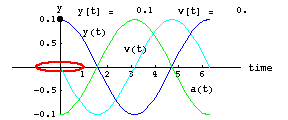 y (t)
= y0 Cos [2 Pi /T] t
y (t)
= y0 Cos [2 Pi /T] t
Physical conclusions for an electron oscillation
Plots of y(t),v(t) and a(t)
Click on plots to stop / start animation
 y (t)
= y0 Cos [2 Pi /T] t
y (t)
= y0 Cos [2 Pi /T] t
v (t) = - y0 [2 Pi / T ] Sin [ 2 Pi / T ] t
a (t) = - y0 [2 Pi /T ] ^2 Cos [2 Pi / T ] t
H.Tahsiri
Conclusions: At t=0,the electon starts at position y(t=0)= y0 = 0.1 m with an initial velocity of v(t=0)=v0=0.At this time the acceleration is maximum in magnitude and is negative ( pointing downward ). After one quarter of the period, t=T/4 ,the electron passes through the origin with maximum speed in a downward direction with zero acceleration.After a three-quarter period t=3T/4,the electron is at a turnaround point characterized by its maximum negative amplitude, y0=-0.1 m. At this point the electron is at its lowest extreme-and zero velocity. The acceleration is maximum and possitive, meaning the velocity is becoming possitive, and the electron will subsequently move upward toward the origin.Finally, after one full period (t=T), the electron has come back to its starting point,to a full stop, with a maximum downward acceleration.Without any dampping,our system behaves as a simple harmonic motion. A simple harmonic oscillator oscillates with equal displacement, y0, on either side of the equilibrium position, the center of the ring.Special thing about simple harmonic motion is that the period T and and frequency f are independent of amplitude y0.